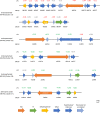The Velvet transcription factor PnVeA regulates necrotrophic effectors and secondary metabolism in the wheat pathogen Parastagonospora nodorum
- PMID: 39127645
- PMCID: PMC11316297
- DOI: 10.1186/s12866-024-03454-7
The Velvet transcription factor PnVeA regulates necrotrophic effectors and secondary metabolism in the wheat pathogen Parastagonospora nodorum
Abstract
The fungus Parastagonospora nodorum causes septoria nodorum blotch on wheat. The role of the fungal Velvet-family transcription factor VeA in P. nodorum development and virulence was investigated here. Deletion of the P. nodorum VeA ortholog, PnVeA, resulted in growth abnormalities including pigmentation, abolished asexual sporulation and highly reduced virulence on wheat. Comparative RNA-Seq and RT-PCR analyses revealed that the deletion of PnVeA also decoupled the expression of major necrotrophic effector genes. In addition, the deletion of PnVeA resulted in an up-regulation of four predicted secondary metabolite (SM) gene clusters. Using liquid-chromatography mass-spectrometry, it was observed that one of the SM gene clusters led to an accumulation of the mycotoxin alternariol. PnVeA is essential for asexual sporulation, full virulence, secondary metabolism and necrotrophic effector regulation.
Keywords: Parastagonospora nodorum; Necrotrophic effector; Secondary metabolite; Velvet A; Wheat.
© 2024. The Author(s).
Conflict of interest statement
The authors declare no competing interests.
Figures






Similar articles
-
A functionally conserved Zn2 Cys6 binuclear cluster transcription factor class regulates necrotrophic effector gene expression and host-specific virulence of two major Pleosporales fungal pathogens of wheat.Mol Plant Pathol. 2017 Apr;18(3):420-434. doi: 10.1111/mpp.12511. Epub 2017 Jan 24. Mol Plant Pathol. 2017. PMID: 27860150 Free PMC article.
-
The candidate transcription factors PnAtfA, PnCrz1, and PnVf19 contribute to fungal morphogenesis, abiotic stress tolerance, and pathogenicity in the wheat pathogen Parastagonospora nodorum.Fungal Biol. 2025 May;129(3):101565. doi: 10.1016/j.funbio.2025.101565. Epub 2025 Mar 8. Fungal Biol. 2025. PMID: 40222766
-
The necrotrophic effector SnToxA induces the synthesis of a novel phytoalexin in wheat.New Phytol. 2013 Oct;200(1):185-200. doi: 10.1111/nph.12356. Epub 2013 Jun 19. New Phytol. 2013. PMID: 23782173
-
The Necrotrophic Pathogen Parastagonospora nodorum Is a Master Manipulator of Wheat Defense.Mol Plant Microbe Interact. 2023 Dec;36(12):764-773. doi: 10.1094/MPMI-05-23-0067-IRW. Epub 2023 Dec 22. Mol Plant Microbe Interact. 2023. PMID: 37581456 Review.
-
Septoria Nodorum Blotch of Wheat: Disease Management and Resistance Breeding in the Face of Shifting Disease Dynamics and a Changing Environment.Phytopathology. 2021 Jun;111(6):906-920. doi: 10.1094/PHYTO-07-20-0280-RVW. Epub 2021 Jul 27. Phytopathology. 2021. PMID: 33245254 Review.
References
MeSH terms
Substances
Supplementary concepts
Grants and funding
LinkOut - more resources
Full Text Sources

